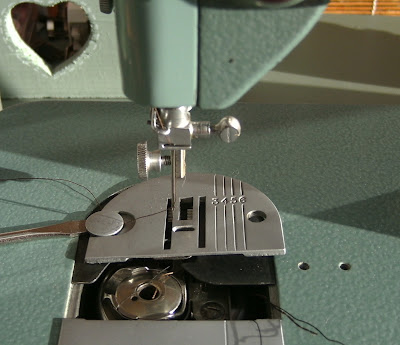For those who don't know, this is my Featherweight.
So your Featherweight has arrived, what now?
Have a good look at the manual before you touch the machine. If you haven't got one, click on this 221 Manual
Before switching it on, check the electric cords making sure they are not frayed or split, its a good idea to use a circuit breaker on these old machines. Make sure that it is the right voltage for the Country you are in, USA is different to the UK for instance. Check the foot control for cracks, remember it is made of Bakelite which is an early plastic and is brittle so don't drop it. If when you switch on the machine and it runs on its own without you pressing the foot control, switch it off at the mains and take it to a qualified electrician/service engineer.
Have a good look around the machine, turn the hand wheel by hand to see if the needle goes up and down easily, check the belt isn't too tight or loose, if its frayed, order a new one. Have a good clean using a lint brush around the feed dogs and around where the bottom bobbin goes in, have a good look for any jammed threads.
Check the manual to see where to oil it, only use Singer Machine oil and one drop in each oiling point. I use a vintage Singer oil can for this, its tiny so easy to use. Black Singer motors have lubrication tubes (the white ones don't have these tubes) which need filling with Singer Lubrication, don't what ever you do put oil down these tubes you will ruin the motor.
Only use a soft cloth on the paintwork, if its dirty you can use a couple of drops of Singer machine oil on a soft cloth to clean it, wipe don't rub (the decals can rub off easily). Buff with a clean cloth. The paintwork chips easily so take care when moving it, I used to use large dressmaking scissors when cutting the threads but after clunking my machine with them a couple of times, now only use embroidery scissors with plastic handles around the machine. Even chunky bracelets can chip paint.
Needle size is 2020 aka 15x1 and aka 130/705. You can use vintage Singer needles, the ones from England, USA or Germany are the best ones, sometimes to later ones made in Brazil cause skipped stitches. If you can't get vintage ones Schmetz universal ones are the best. The needle is inserted with the flat side on your left as you look at the machine and threaded right to left. Needles come in different thicknesses, from 10 (for fine material) up to 16 (for tough material).
Featherweights can smell of old oil and can be quite stinky, there is a drip tray under the machine that has a felt panel to soak up the oil, this is made of pure wool and over time the oil rots it and it smells horrible. New felt panels are available from http://april1930s.corecommerce.com/Parts-Manuals-amp-Service/Parts-for-the-Singer-Featherweight-221-222-and-301/Felts-Accessories/. You might have to scrape the old one off with a flat blade, I used a wallpaper stripper.
The rubber feet on the bottom of the machine are often melted for some reason, these can be removed using the large Singer screwdriver on the screw directly in the middle of the pad. You can buy new feet from if you live in the UK http://www.singersewinginfo.co.uk/featherweight_parts/ and from April1930 (use the link above) for USA owners. Both these sites have loads of information on Featherweights. Another good USA website is http://www.novamontgomery.com/index.htm The rubber feet do leave black marks on hard surfaces which are tricky to clean off so I always put a cutting mat under mine so it doesn't mark the furniture.
If the carrying case smells of mould, you can put it in the baking sun (might have to wait for the summer to arrive) for a few days making sure that you support the lid so it can't blow over and smash the locks.
The Featherweights are great for free motion embroidery using a feed dog cover and a hopping foot. But, and there is a but, the motor can overheat if you sew for a long time so short bursts are best and regular hand on motor to see if its hot. STOP let it cool down. I got carried away with mine once and it overheated which caused it not stop when I lifted my foot off of the controller! Plug pulled instantly. Scary, thought I had broke it but once it had cooled right down it was fine.
Have fun with your wonderful machines, if you take care of them, they will last.
Cheers
Sharon





















